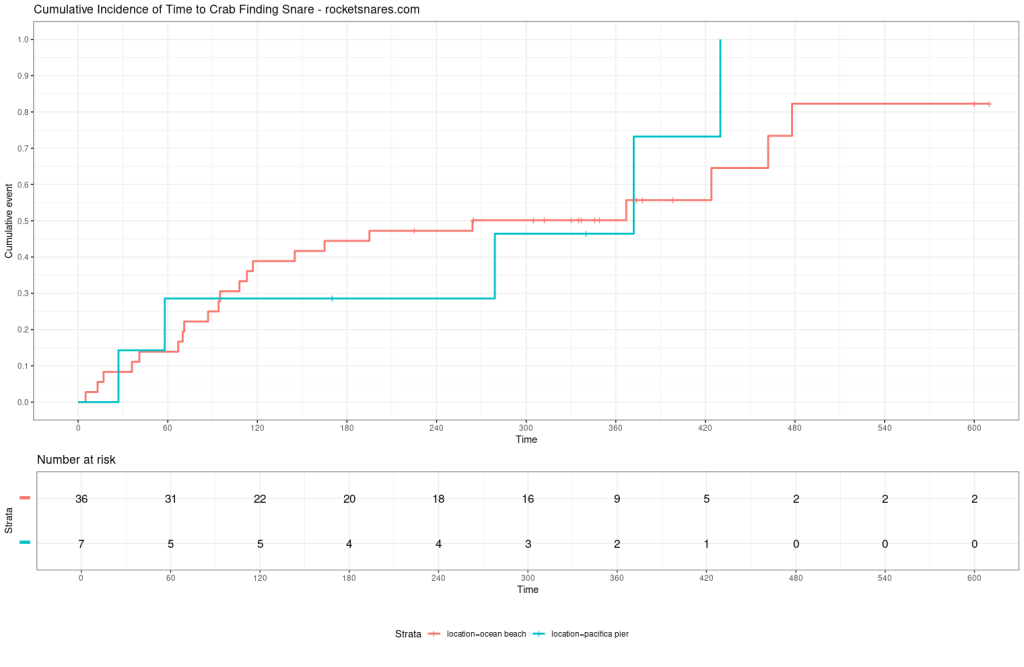Based on our underwater videos, we suggest pulling your crab snare after 3-5 minutes.
Methods
We attached a waterproof camera to a crab snare to collect data on how long it takes a Dungeness crab to find a snare. All videos are available on our Youtube channel. Below is a sample video where we cast a snare directly on top of a Dungeness crab!
Each video is annotated with the “time to crab” (i.e. how long did it take a crab to find the snare) and “time to pull” (i.e. how long before we reeled in the snare). We then conducted a survival analysis on this time to event data. A survival analysis properly accounts for censoring – times when we pulled the snare before a crab found it. In these cases, the “time to crab” is censored (not observed) because we don’t know how long it would have taken a crab to find the snare if we had left it out.
Note that we are concerned with whether a crab found the snare and not with whether we succeeded in catching a crab. If a crab found the snare, catching it has its own independent probability of success. As shown in the videos, a crab may no longer be on the snare if you wait too long to pull – a strong current can separate it from the snare or it can steal the bait and leave. If a crab is still on, snares have different designs, loop orientations, and loop materials that affect pull success. These variables are hard to quantify, so we analyzed the base case of whether or not a crab was observed.
Results
The results of the “Time to Crab Finding Snare” analysis are shown in the cumulative incidence plot below. At the beach (red line), a crab found the snare within 3 minutes (Time = 180 seconds) approximately 45% of the time.

Given these results, how can we maximize our catch? Let’s consider some simplified scenarios:
- Wait 10 minutes to check the snare – If you wait 10 minutes to check the snare, then a crab will have found it 80% of the time. The expected value is 0.80 * 1 crab = 0.8 crabs per 10 minutes.
- Wait 5 minutes to check the snare – If you wait 5 minutes to check the snare, then a crab will have found it 50% of the time. That’s a lower percentage than checking after 10 minutes, but you can either 1) wait another 5 minutes or 2) recast the snare to a different spot for another 50% chance. With 2 casts in the same 10 minute span, there is a 25% chance that neither cast will find a crab, a 50% chance that one cast will find a crab, and a 25% chance that both casts will find a crab. Thus, the expected value is 0.25 * 0 crabs + 0.50 * 1 crab + 0.25 * 2 crabs = 1 crab per 10 minutes.
- Wait 3 minutes to check the snare – If you wait 3 minutes to check the snare, then a crab will have found it 45% of the time. Again, you can either 1) wait another 3 minutes or 2) recast the snare for another 45% chance. With 3 casts in the same 10 minute span as the first scenario, there are 8 combinations of crab/no crab with an expected value of 1.35 crabs per 10 minutes.
Theoretically, you could find the time with the maximum expected value by examining all points along the cumulative incidence curve. However, shorter time periods run into practical limitations. On 1 pole, reeling and casting every 3 minutes is physically demanding, especially in the surf. If you run 2 poles, that’s non-stop reeling and casting every 1.5 minutes. Thus, 3 to 5 minutes is probably the sweet spot for what’s physically possible while maximizing crab encounters per minute.
Our analysis has some limitations. First, our data is from a one month snapshot of essentially one location, so our results may not generalize to different times during the season, different crabbing conditions, and different locations. Although we’d like to collect more data, we burned through 4 cameras during this experiment (one camera leaked, one camera was lost when the line snapped, one camera got snagged on a piling at the pier, and one camera was potato quality). Even with the cheapest cameras, it’s not sustainable to lose cameras at this rate. We also think the camera reduced catch rates. As you might imagine, a snare with a camera bolted on is harder to reel in through the sand and surf. While this experiment was enlightening, our primary goal is to catch crabs.
Conclusion
We think reeling in the snare after 3-5 minutes and recasting to a different area will maximize your expected crab count.
